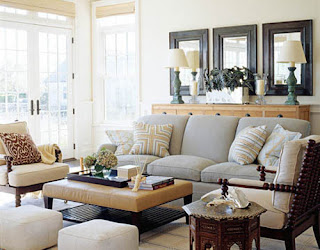The living room is a
gathering spot for family and friends to spend quality time. It's also a place
where you can take simple steps to be more energy-efficient.
Table Lamp
Replace your highest-use
fixtures or the light bulbs in them with ENERGY STAR models.
Living room table and
floor lamps are two of the most used light fixtures in a home. Conventional
torchiere lamps also can be the highest wattage light fixtures in the home.
ENERGY STAR qualified lighting fixtures and replacement bulbs can be found at
home improvement and hardware stores, lighting showrooms, and other retail
stores, including online outlets.
Ceiling Fan w/
Lighting
Depending on when and
how you operate them, ceiling fans can provide comfort and help you save on
your energy bills.
In the winter, your
ceiling fan can help improve your comfort. Most fans have a switch that allows
you to reverse the motor and operate the ceiling fan in the opposite direction.
This produces a gentle updraft, which forces warm air near the ceiling down
into the living space.
In the summer, check
to make sure your fan is blowing air downward to help you feel cooler. On
hotter days, dialing up the thermostat by only two degrees and using your ceiling
fan can lower air conditioning costs by up to 14% over the course of the
cooling season. Use low wattage CFLs in the ceiling fan light fixture for
cooler light bulbs and more energy savings. And remember: Ceiling fans cool
only people, not the room, so when you leave the room, turn the ceiling fan
off.
Light Switch
Remember to always
turn off your lights when leaving a room.
Drapes
During cold weather,
take advantage of the sun's warmth by keeping drapes open during daylight
hours. To keep out the heat of the summer sun, close window shades and drapes
in warm weather.
Power Strip
Use a power strip as
a central “turn off” point for electronics, video games, and computers when not
in use.
Air Register
Make sure that the
connections at vents and registers are well-sealed where they meet the floors,
walls, and ceiling. These are common locations to find leaks and disconnected
ductwork. Also make sure that all vents are clear of any furniture or rugs to improve
air flow and comfort. If your home has radiators, you can place heat-resistant
reflectors between radiators and walls. In the winter, this will help heat the
room instead of the wall.
Window
During the winter
months, replace your screens with storm windows to provide an extra barrier to
the cold outside air. Caulk and weather-strip around windows and doors that
leak air. If replacing windows, choose ENERGY STAR qualified models designed
for your area, and save $150–500 per year in energy costs. With proper
installation to ensure all gaps around them are sealed, ENERGY STAR qualified
windows can help improve your comfort, cut drafts, and reduce fading of
interior furnishings.
Learn how to fix problems
with moisture on windows in your home.
Apply caulk and weather stripping around windows and doors that leak air.
Fireplace Damper
Close the flue damper
tightly when not in use. Otherwise, warmed or cooled air can easily escape from
the house.
A chimney is designed
to remove by-products from a fire by creating a draft. The draft also pulls air
from your home up the chimney-air that you've paid to cool or heat. Even
without a fire in the fireplace, there still will be a draft in the chimney as
long as there's a temperature difference between indoors and out. Closing the
damper will keep air conditioned (or warmed) air in the living space where it
belongs.
Home Theatre System
Look for the ENERGY
STAR on consumer electronics products. These products use less energy without
sacrificing quality or performance. Seal any holes with caulk or spray foam
where pipes or TV/cable wires and vents enter or exit your home.
Consumer electronics
play an increasingly larger role in your home's energy consumption, accounting
for up to 15 percent of household electricity use. Many consumer electronics
products use energy even when switched off. Electronics equipment that has
earned the ENERGY STAR help save energy when off, while maintaining features
like clock displays, channel settings, and remote control functions.
Outlet
Unplug any battery
chargers or power adapters when not in use.



No comments:
Post a Comment